Building regulations - proposed changes to energy standards, etc: consultation analysis
An analysis of the responses to the 2021 public consultation on a review of building standards relating to energy standards and associated topics, including ventilation, overheating and electric vehicle charging infrastructure.
5 Part 4 – Ventilation
Following the commissioning of research into the impact of previous 2015 ventilation amendments to ventilation standards for new homes in 2021, it is the intent of BSD to undertake a fuller review of ventilation provision for both domestic and non-domestic buildings from 2022.
Accordingly, changes proposed at this time are focused on domestic ventilation and are limited to those which are considered to be directly relevant to the introduction of improved energy standards or (in response to published research) can better address the delivery of expected levels of ventilation and good indoor air quality.
5.1 General revision expansion of core guidance on ventilation provision
5.1.1 Question 32
Do you support the proposed revisions to the presentation of guidance on ventilation and the incorporation of the 'domestic ventilation guide' into the Technical Handbooks?
In total, 86 responses were received to this question and 71 responses to the accompanying open question where respondents were asked to provide more detail to support their answer. Eleven respondents provided an open response but did not answer the preceding open ‘yes/no’ question. Most of the responses received stated ‘no comment’.
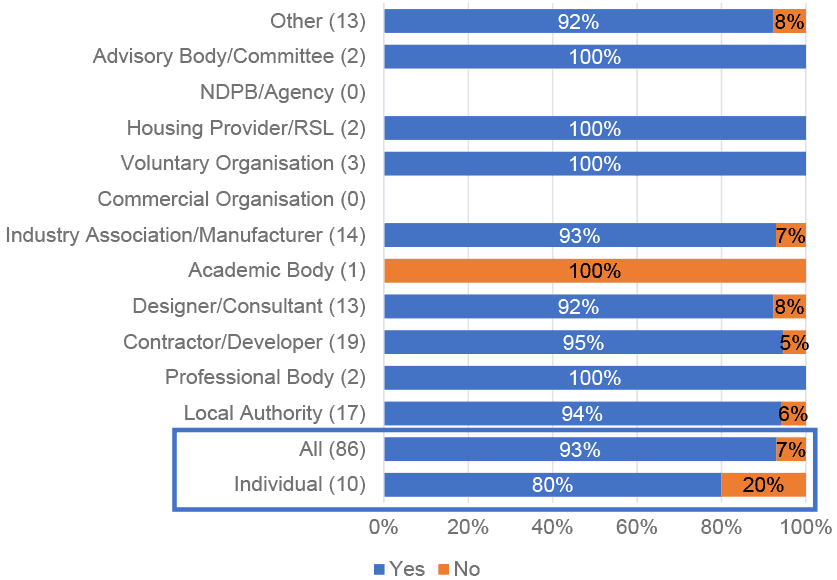
Base: 86 respondents (90 no response) NB Individual respondents are listed separately at the bottom for information - as they are included in organisation responses (per Section 2.3)
5.1.2 Analysis
Overall, 93% of respondents to this question were supportive of the proposed revisions and incorporation of the 'domestic ventilation guide' into the Technical Handbooks (Figure 39).
5.1.3 Support for the proposal
The predominant themes across all respondents were that incorporation of the 'domestic ventilation guide' into the Technical Handbooks would provide greater clarity and improve accessibility and awareness. Several respondents mentioned the benefits of having a ‘single point of reference’. Alongside this, a few respondents stated that revisions to the guidelines would also improve clarity.
Several respondents state that the revisions would be consistent with normal practice.
A few other respondents who supported the proposed revisions felt that compliance might be improved as a result.
A few respondents welcomed the new approach because they believe it aligns with the rest of the UK.
5.1.4 Technical considerations
A few respondents mentioned technical considerations in their responses:
- One respondent perceived there was an error regarding continuous ventilation.
- One Contractor/Developer highlighted a need to consider sufficiency of openable window casements to meet the increase of 1/30th to 1/20th floor area.
- One research organisation commented that the level of technical detail must be sufficient to ensure that system design can be effectively undertaken.
- One Local Authority respondent suggested that guidance might be improved by highlighting issues involving an incorrect ventilation strategy, in particular with remedial work needed after better than anticipated air tightness test results.
- An architect called for more focus on air quality.
Only one respondent supported the proposed revisions but was opposed to their inclusion in the Technical Handbooks, stating that it would be more helpful to keep a clear distinction between guidance, including best practice, and regulation (the minimum legal standards).
5.1.5 Not in support of the proposal
Four of the six respondents who were not supportive of the proposals chose to give reasons.
- Preference for the Guidance to be in a separate document with hyperlinks from the ‘Technical Handbook’.
- Keeping guidance separate would allow the industry to collaborate on updates to supplementary information as technologies develop and provide an opportunity for industry to feed back to the Scottish Government on matters concerning Building Regulations.
- The guidance would require a full house design
- The proposals were suggested to contain an error regarding continuous and intermittent ventilation.
5.2 Revision of guidance on purge ventilation
5.2.1 Question 33
Do you agree with the revision of guidance to clarify the function of purge ventilation and increase provision to align with that applied elsewhere in the UK?
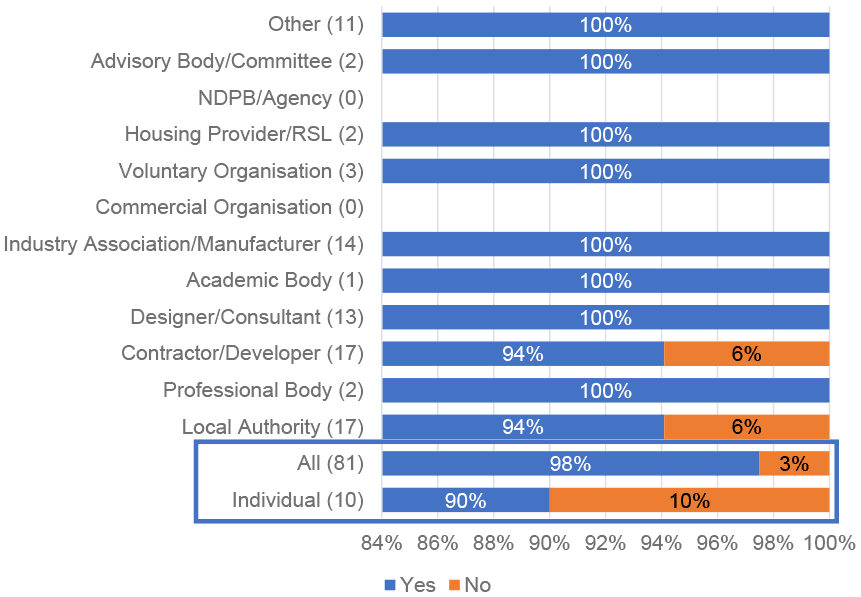
Base: 81 respondents (95 no response) NB Individual respondents are listed separately at the bottom for information - as they are included in organisation responses (per Section 2.3)
In total, 81 responses were received to this question (Figure 40) and 61 responses to the accompanying open question where respondents were asked to provide more detail to support their answer. Ten respondents provided an open response but did not answer the preceding open ‘yes/no’ question. Most of these were ‘no comment’.
5.2.2 Analysis
Of the 81 respondents to this question, 98% were in agreement with the proposal.
5.2.3 Support for the proposal
The main theme among respondents was that alignment with the rest of the UK would be a positive outcome, reducing confusion and aiding simplification. Related comments on this point were raised:
- Challenges for developers and supply chains caused by the different guidance for Scotland would be addressed.
- Caution should be observed because of the variations in climate across the UK and within Scotland.
A specific section of guidance recommending increase in provision from 1/30th to 1/20th of floor area for purge ventilation was referenced by several respondents who agreed with the proposal.
A few respondents highlighted how the guidance is particularly relevant considering the increased importance of ventilation due to the pandemic.
Seven respondents made suggestions to improve the guidance:
- dMEV was felt to be suboptimal to MVHR, so MVHR should be applied to all situations.
- Due to designed and tested airtightness often being significantly different, it would be beneficial to require sample testing throughout the Building Warrant process in order to avoid abortive work and re-design of ventilation strategies.
- Consideration of the suitability of external noise levels to allow the opening of windows for “normal” ventilation conditions through the principles of good acoustic design should be made at Planning Stage.
- Possible difficulties for verifiers in determining if windows meet opening requirements.
- Designers should be alerted to the fact the figures in Table 3.6a may need to be increased in order to comply with the overheating requirements.
- Where mechanical purge is required, it is appropriate to require this to be extracted directly to the outside and that clarity should be provided on the requirement for whole house purge.
5.2.4 Not in support of the proposal
One of the two respondents who were not in favour of this revision to the guidance – a Contractor/Developer – made the comment that it does not provide flexibility within design. The other respondent did not provide further comment.
5.3 Clarification on ventilation solutions in low infiltration new dwellings
5.3.1 Question 34
Do you support reference to a single option for continuous mechanical extract ventilation which can have centralised or decentralised fans, with the same design parameters being applied to the system in each case?
In total, 69 responses were received to this question and 63 responses to the accompanying open question where respondents were asked to provide more detail to support their answer.
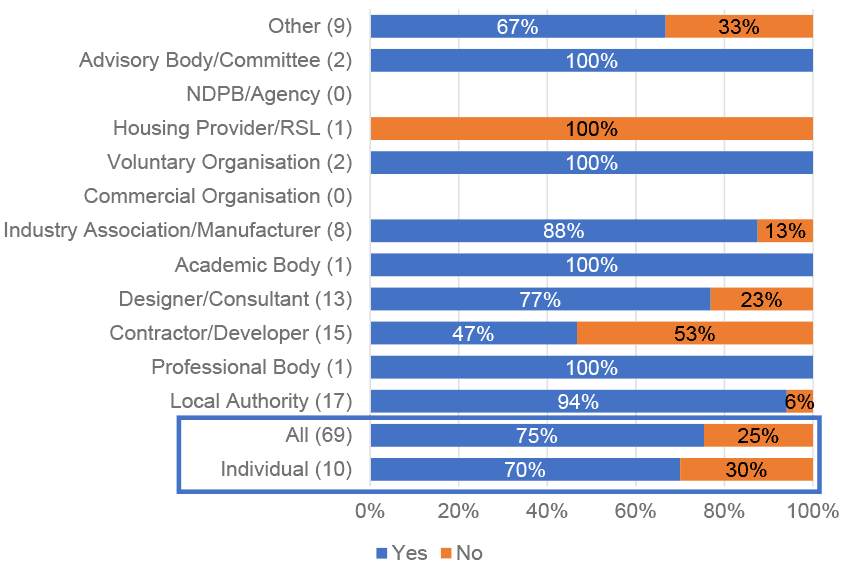
Base: 69 respondents (107 no response) NB Individual respondents are listed separately at the bottom for information - as they are included in organisation responses (per Section 2.3)
5.3.2 Analysis
Overall, 75% of respondents to this question were supportive of the proposal, with 25% against it (Figure 41).
5.3.3 Support for the proposal
Several respondents who agreed with the proposal and went on to stress the importance of careful consideration at the design and installation stage. Several stated that the proposed way of working removes confusion, with one Contractor/Developer going on to say that they have been working in this way for a while.
A campaign response repeated by several respondents, agreed that a single option for continuous mechanical extract ventilation should have the same design parameters regardless of fan position as this would aid in limiting the malfunction or sub-optimal performance of DMEV systems where supply air paths are convoluted.
A few respondents advocated a mechanical supply and extract ventilation system with heat recovery; an additional respondent also expressed a preference for systems to include some form of meaningful heat recovery.
5.3.4 Not in support of the proposal
Respondents who were unsupportive of the proposal expressed a variety of concerns.
Several respondents repeated a campaign response which raised concerns surrounding the use of centralised Mechanical Ventilation with Heat Recovery (MVHR), flagging the operation of MVHR as a bigger issue as they perceive that ongoing maintenance required to ensure efficient and safe working could cause problems. Respondents stated that MVHR systems are normally located in loft spaces and will require regular checks and maintenance regimes such as the replacement of filters etc. which could lead to significant increase in annual costs for homeowners.
A few Contractor/Developer respondents repeated concerns about maintenance of centralised MHVR.
5.3.5 If you have any further views (re Question 34) on the use of continuous mechanical extract to deliver effective ventilation in both low infiltration (3-5 m³) or higher infiltration (>5 m³) buildings, we would also welcome your comments.
In total, 32 respondents provided comments in response to this open question.
5.3.6 Analysis
Several respondents, mainly from Local Authorities highlighted the need for guidance for those verifying and commissioning installations. These respondents asked for guidance to cover the following specific issues; the undercut of fire doors to aid air pathways; non-domestic buildings, which are empty for extended periods of time; and on how to deal with a situation where the continuous extract system is designed to suit a higher infiltration rate than what is actually achieved.
Several respondents stressed that for systems to work well in practice there needs to be guidance for end users.
A few respondents stated that MVHR systems should be mandatory in new buildings while a Contractor/Developer called for cMEV or dMEV to be mandatory with design airtightness below 5 m3. Reasons centred on benefits to indoor air quality in a climate where it is not often possible to open windows for adequate ventilation due to inclement weather.
Various technical considerations were highlighted:
- The impact of breakdowns in centralised systems and requirements for maintenance and periodic servicing.
- The advantages of intermittent extraction in terms of heat recovery not being required and any fan noise nuisance experienced by occupants is of short duration.
- Using larger sizes of dMEV products (125 mm diameter) provide a good solution to ensure higher ventilation rates can be used where needed at lower noise levels.
- Extraction and supply rates should be balanced so the humidity within the building does not drop to levels that are detrimental to human health.
5.4 Background ventilators in continuous mechanical extract solutions
5.4.1 Question 35
Do you support introduction of proposed guidance on default minimum size of background ventilator for continuous mechanical extract systems?
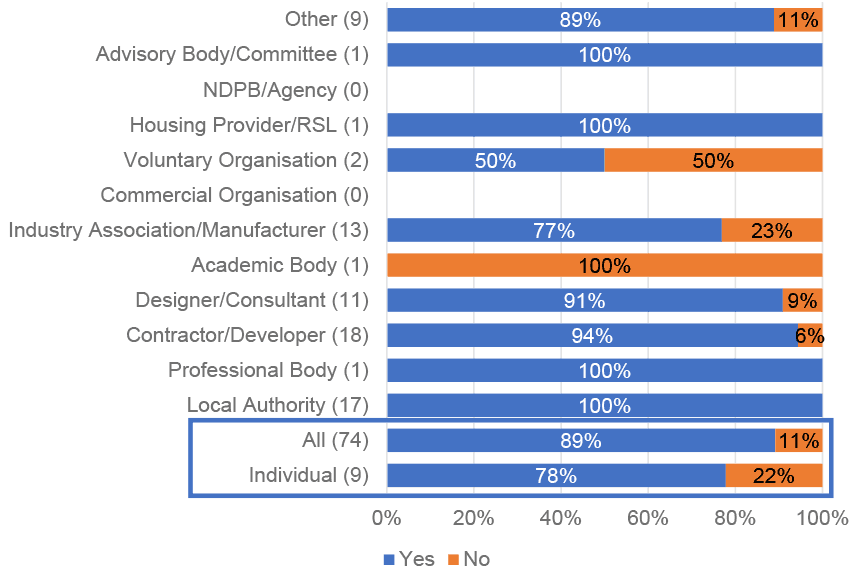
Base: 74 respondents (102 no response) NB Individual respondents are listed separately at the bottom for information - as they are included in organisation responses (per Section 2.3)
In total, 74 responses were received to this question and 59 responses to the accompanying open question where respondents were asked to provide a summary of the reason for their view, including any specific concerns they consider may arise from the proposed level of background ventilation or its application in the design of systems. Fourteen respondents provided an open response but did not answer the preceding open ‘yes/no’ question. Most of these were ‘no comment’.
5.4.2 Analysis
Overall, 89% of respondents to this question were in support of the proposal (Figure 42).
Around a quarter of the 59 respondents choosing to expand on their answer to the first part of the question simply stated that the proposals would add simplification, consistency, or clarity.
A campaign response from several organisations highlighted a perceived need to consider the size of ventilators to improve air quality, going on to state that current practice may result in levels of air pollution and CO in new buildings, which although will remain within limitations will be closer to the upper threshold. Similarly, a few respondents (two of whom supported the proposal) repeated a campaign response drawing attention to the potential problems if background ventilation requirements are set too low.
These respondents acknowledged that background ventilation is difficult to control and went on to that state having a demand-controlled ventilation system as a localised option could aid in the ventilation performance where other solutions are not viable, as this could provide better control of indoor air quality than a continuous extract system.
Contrasting with this was the view of several respondents who welcomed the proposal of guidance for minimum size for background ventilators but do not agree that it should be 5000 mm². These respondents highlighted equivalent guidance in the proposed Part F in England (which is 4000 mm²). It was suggested this may cause some confusion where developers are working across the border and also cause difficulties because standard products on the market correspond to the 4000 mm² requirement. These views were supported by a few other respondents who would prefer recommended size to be 4000 mm², stating that there is a risk that larger ventilators may lead occupants to block them to limit unwanted draughts.
A few respondents repeated a campaign response agreeing that for financial or operational reasons some buildings will need to utilise natural ventilation or a mixed mode of natural ventilation with continuous mechanical extract. But they recommended that regulations for new buildings should be to Passivhaus Standard.
Another perceived issue of differing Scottish and English standards was highlighted by a Contractor/Developer who suggested that intermittent extract flow rates shown for continuous extract ventilation systems should align with the UK flow rates. An Approved organisation agreed that guidance is required but supported following the guidance in England for consistency, however, a Designer/Consultant stated that references to English standards should not be within Scottish technical standards.
5.5 Ventilation solutions in very low infiltration new dwellings
5.5.1 Question 36
Should continuous mechanical extract systems be considered a viable solution in very low infiltration dwellings and, if so, under what circumstances?
In total, 70 responses were received to this question and 63 responses to the accompanying open question where respondents were asked to provide a summary of the reason for their view. Twelve respondents provided an open response but did not answer the preceding open ‘yes/no’ question. Most of these were ‘no comment’.
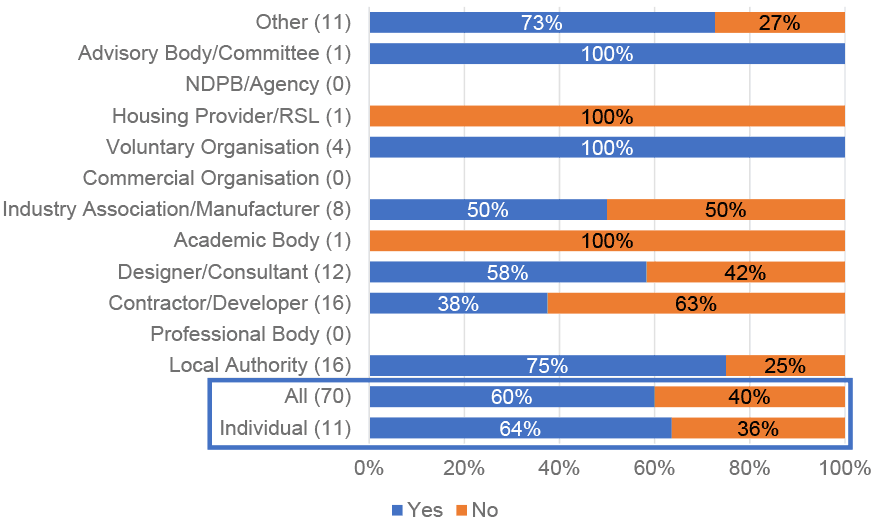
Base: 70 respondents (104 no response) NB Individual respondents are listed separately at the bottom for information - as they are included in organisation responses (per Section 2.3)
5.5.2 Analysis
Overall, 60% of respondents were in agreement with the proposal (Figure 43).
5.5.3 Support for the proposal
Among respondents agreeing with the proposal and commenting on the circumstances in which continuous mechanical extract systems should be considered a viable option, most confirmed this should be for low infiltration dwellings. It should be noted that commentary provided by respondents indicates that the reference to ‘continuous mechanical extract’ may have been read as ‘continuous mechanical supply and extract’ – see below.
Many respondents, while agreeing the proposal, went on to qualify their response.
Many respondents stated that there should ideally be some form of heat recovery.
Several respondents who agreed with the proposal, went on to state how occupant behaviour influences how ventilation functions, with two respondents stating that occupants should be prepared to lose heat to achieve adequate air changes.
Several respondents agreeing with the proposal referred to trickle vents, one stating that an advantage of MEV systems is that they remove the reliance on trickle vents which may be installed incorrectly, another respondent stated they might be used incorrectly.
Several respondents stated that MEV systems should include adequate provision for trickle ventilation.
A campaign response repeated by two respondents who did not respond to the first part of the question called for the ventilation rate to be linked to occupancy and specifically to deliver an air change rate of 30 m3/h per person.
5.5.4 Not in support of the proposal
Among respondents objecting to the proposal, the most common reason (given by nine respondents) was the consequences of failure when reliant on a single fan.
Several respondents objected to the proposal, citing a preference for MHVR.
Several respondents rejecting the proposal had concerns about the sufficiency of background ventilation to facilitate the required air changes.
5.5.5 We would also like to hear your views on whether heat recovery should be mandated for packaged supply/extract systems. - Please provide your comments below:
In total, 62 responses were received to this open question.
5.5.6 Analysis
Around 70% of respondents were in favour of mandating heat recovery systems. The most common benefits mentioned were reduction in energy consumption and subsequent carbon emissions together with maintaining internal comfort for occupants.
Energy consumption and carbon reduction savings from MHVR were disputed by several respondents who disagreed that heat recovery systems should be mandated.
Other respondents called for more research before mandating heat recovery systems.
Respondents in favour mentioned the opportunity to include an MVHR at the design stage thereby future proofing them for low carbon heating solutions, also that, should systems be mandatory, developers need to be forced into providing adequate installations otherwise they may deliver whatever is cheaper and more convenient for them.
A few respondents stated that mandating may reduce flexibility and increase dependence on bolt on components to achieve compliance instead of innovative design and use of buildings.
A few respondents were of the opinion that the requirement for heat recovery may not be suitable in all situations, one stating it should be led by section 6 of the building standards, the other that it could be mandated on certain domestic buildings based on size or where centralised systems are possible e.g., in apartment blocks.
5.6 Incorporation of secondary guidance into the Handbook
5.6.1 Question 37
Do you support the proposed incorporation of a revised version of the current 'domestic ventilation guide' as an annex to section 3 (environment) of the Domestic Technical Handbook? Question 9 - We would be grateful for your comments on the content of the proposed Annex and whether there are elements absent from the current guide or which would be better presented.
There were 86 responses to the closed question, and 94% were in support of the guidance (Figure 44). Six respondents provided an open response but did not answer the preceding open ‘yes/no’ question. Most of these were ‘no comment’.
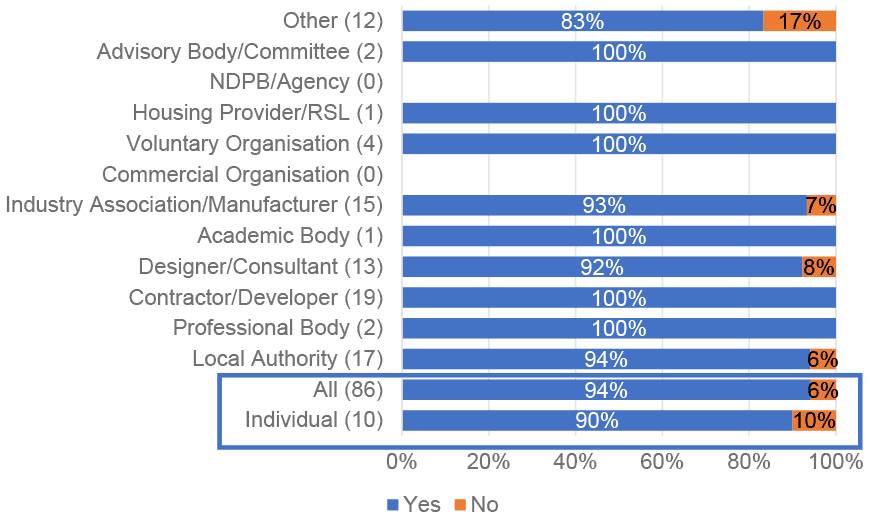
Base: 86 respondents (90 no response) NB Individual respondents are listed separately at the bottom for information - as they are included in organisation responses (per Section 2.3)
5.6.2 Analysis
Overall, 90% of respondents were in agreement with the proposal (Figure 43).
There were 37 responses to the open question, some respondents reiterated their responses to earlier questions, others simply chose to comment that the guidance is good, with some going on to give reasons e.g., it will make referencing easier for designers and verifiers.
Several respondents asked for the incorporation of clear and simple diagrams, such as flow charts. Some referenced the diagram from page 15 of the consultation document. Other, general comments on the presentation of information included:
- Ensuring documents are electronic, fully indexed and referenced.
- Provision of a simple reference guide.
- Integrating the additional information on ventilation with the domestic ventilation guide provides a simpler method to retrieve or obtain relevant information from a single source.
Several respondents gave suggestions for additions to the guidance, and also commented on parts of the guidance that they considered should be amended. For example:
- Guidance on reducing noise from mechanical extract fans and MVHR systems.
- Additional guidance exploring the impact of massing, solar gain, pressure differential and the opportunities for creating stack ventilation, particularly here high spaces can be incorporated into buildings.
- Information reflecting guidance per Part F of the Approved Documents in England.
A few contractor/developer respondents repeated concerns from previous questions, that guidance should be clearly separated from mandatory requirements to avoid risk of confusion and misinterpretation.
Numerous suggestions were made by one organisation for additional technical guidance, specifically referring to ducts.
5.7 Emphasis on design, commissioning, and testing
5.7.1 Question 38
Are there other elements of the commissioning of ventilation systems that you consider are both practical to implement and useful in providing additional assurance of performance in practice?
In total, 64 responses were received to this question and 41 responses to the accompanying open question where respondents were asked to provide more detail to support their answer. Five respondents provided an open response but did not answer the preceding open ‘yes/no’ question.
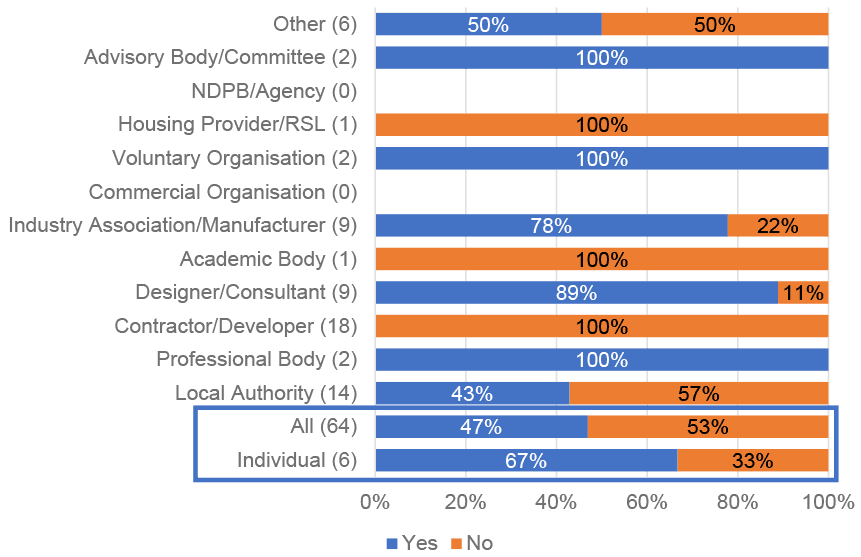
Base: 64 respondents (112 no response) NB Individual respondents are listed separately at the bottom for information - as they are included in organisation responses (per Section 2.3)
5.7.2 Analysis
In total, just under half (47%) of respondents suggested there are other elements of the commissioning of ventilation systems that they consider are both practical to implement and useful in providing additional assurance of performance in practice (Figure 45).
There was strong support among many respondents for staged commissioning for example, an initial commissioning at handover followed up with an in-use rebalancing of systems, based on user feedback, with second stage re-commissioning after 1 year of use of any installed system. The purpose of the second stage commissioning (after a year) was variously described as to re-calibrate systems, re-balance systems, allow adjustments to be made based on user feedback; and to ‘stress-test’ the system in all seasons and allow adjustments required to be made to optimise the system.
Several respondents stressed the importance of guidance for end users. These respondents felt that guidance should be clear and easily understandable in the form of an operational material and should ideally be accessible digitally as well as within a user manual made available at handover.
Several respondents made reference to competence of personnel involved in commissioning systems as well as those designing and installing, respondents stressed that these should suitably trained and competent people.
Several respondents referred to noise levels, with a national organisation calling for guidance to be introduced into the building standards around the noise from mechanical ventilation systems and this to be provided as a test for compliance. A few respondents also stated that noise from mechanical ventilation systems is an issue for many local authorities and effective consultation needs to be undertaken to ensure that any potential issues are identified as early as possible.
A few respondents stated that the commissioning process should include a record of the name of the technician and the company employed by the person carrying out the ventilation testing in the report submitted to the verifier and it should detail of any competencies relevant to this role. A Membership Body also suggested the inclusion of the installers’ details, for accountability purposes
Comments from respondents answering ‘no’ were general responses e.g., stating that every ventilation system should perform as designed once installed. One drew attention to the existence of commissioning apps which they feel may be worth considering in future updates to the regulations.
5.8 Thoughts on domestic and non-domestic ventilation
5.8.1 Question 39
We welcome your thoughts on domestic and non-domestic ventilation, or broader topics which would merit consideration as part of the planned review.
Sixty-two responses to this open question were received.
5.8.2 Analysis
There were few themes discernible in the answers to this question, generally respondents commented on very specific points according to their specialisms, with some respondents going on to recommend evidence to support the points raised:
- Noise levels and their impact.
- Consideration of ventilation in the context of minimising risks from indoor pollutants.
- Levels of background ventilation.
Several respondents mentioned concerns about noise, one suggesting this may benefit from a wider discussion and integration with planning and public health guidance. Two respondents mentioned reports which they feel might contribute to the debate.
Several respondents welcomed the guidance and referenced ventilation practices necessitated by the pandemic to keep occupants safe.
A few respondents were concerned about ventilation in the context of minimising risks from indoor pollutants. Three respondents recommended a publication which details broader issues around ventilation, air tightness, indoor air quality and wellbeing of occupants.
Various other comments were made, however there were no obvious themes to these responses. They included:
- Ventilation should not be subordinate to energy.
- Guidance for retrofit to be prepared with great care stating that retrofit risks trapping in moisture.
- Levels of background ventilation given in Table 3.7a may be too high and could negate some of the benefits of improved thermal insulation and increase Carbon emissions.
- The importance of considering human nature in any proposals because people have greatly differing preferences and behaviours regarding their individual environments.
- A gap in minimum outside air rates between the 8 l/s/person outlined in the Building Standards Technical Handbook and those outlined in CIBSE Guidance and other industry bodies such as the BCO (British Council for Offices).
5.9 Further comments on proposed changes to ventilation standards
5.9.1 Question 40
We welcome any other comments you may wish to make on proposed changes to ventilation standards for domestic buildings.
Forty-four responses to this open question were received.
5.9.2 Analysis
Respondents tended to make specific individual points however, a number of themes are discernible.
The necessity to harmonise energy and ventilation standards was highlighted as a concern by several respondents. A campaign response repeated twice warned of the perceived dangers that a halfway approach will result in unwanted heat loss and a widening performance gap.
A few respondents had concerns about appropriate ventilation standards for retrofit, making a specific reference to traditional buildings.
Trickle ventilation and the need to provide adequate ventilation in dwellings was mentioned by a few respondents. An Industry association/manufacturer noted how trickle vents in windows reduce thermal efficiency and are often permanently closed by occupiers. A Local Authority commented that where trickle vents are in a window head their exact area is not measured and that there is likely a high proportion of non-compliance of this aspect. It was also highlighted that the revised standards do not appear to allow trickle ventilation to be ducted.
A few respondents suggested that ventilation must cover both supply and extract as they are inextricably linked.
A few respondents drew attention to ventilation of garages, where current guidance refers to fortuitous ventilation through garage doors, stating this should re-considered where new garage door installations are typically much tighter.
The content of two responses was of a highly technical nature.
Contact
Email: buildingstandards@gov.scot
There is a problem
Thanks for your feedback